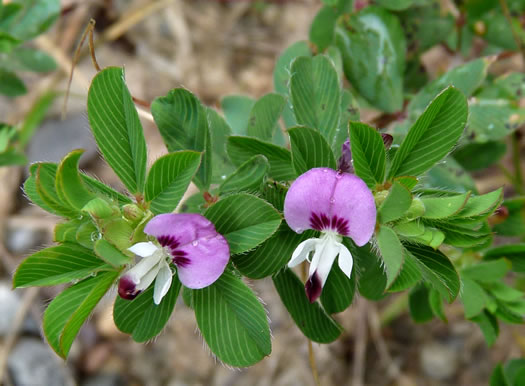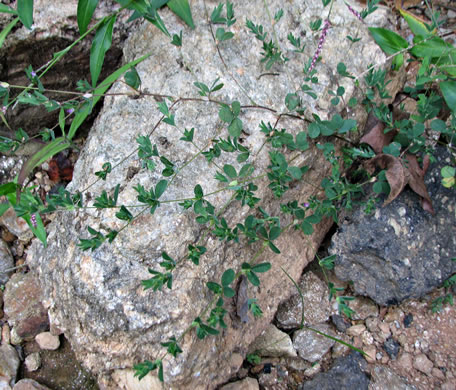Spermatophytes (seed plants): Angiosperms (flowering plants): Eudicots: Core Eudicots: Rosids: Fabids: Fabales
WEAKLEY'S FLORA OF THE SOUTHEASTERN US (4/24/22):
Kummerowia stipulacea
FAMILY
Fabaceae
Go to FSUS key
Dig deeper at SERNEC, a consortium of southeastern herbaria.
You may find it helpful to read Lespedeza Species in the Carolinas by Bill Stringer.
Check out EDDMapS.org to see where this has been reported.
Learn more about Kummerowia from the Vascular Plants of North Carolina.
SYNONYMOUS WITH
PLANTS NATIONAL DATABASE:
Kummerowia stipulacea
FAMILY
Fabaceae
SYNONYMOUS WITH Native & naturalized Leguminosae (Fabaceae) of the US (Isely, 1998)
Kummerowia stipulacea
SYNONYMOUS WITH VASCULAR FLORA OF THE CAROLINAS (Radford, Ahles, & Bell, 1968) 098-27-001:
Lespedeza stipulacea FAMILY Fabaceae
COMMON NAME:
Korean-clover, Korean Lespedeza
To see larger pictures, click or hover over the thumbnails.
Richard and Teresa Ware rtw_k_stipulacea_4
September
Leaflets emarginate at the apex, conspicuously spreading-ciliate, per Weakley's Flora (2012).
![]() COMPARE
leaves that are trifoliolate and pinnately compound
COMPARE
leaves that are trifoliolate and pinnately compound
Terry Holdsclaw tdh_kummerowia_stipulacea
September Catawba County NC
Mid-stem leaves with petioles 4-10mm long; stems antrorsely appressed-strigose, per Weakley's Flora.
WEAKLEY'S FLORA OF THE SOUTHEASTERN US (4/24/22):
Kummerowia stipulacea
FAMILY
Fabaceae
SYNONYMOUS WITH
PLANTS NATIONAL DATABASE:
Kummerowia stipulacea
FAMILY
Fabaceae
SYNONYMOUS WITH
Native & naturalized Leguminosae (Fabaceae) of the US (Isely, 1998)
Kummerowia stipulacea
SYNONYMOUS WITH
VASCULAR FLORA OF THE CAROLINAS (Radford, Ahles, & Bell, 1968) 098-27-001:
Lespedeza stipulacea
FAMILY
Fabaceae
If a search such as "Carex leptalea var. leptalea" doesn't deliver the results you want, try "Carex leptalea".
Or, to minimize chances of a misspelling, try just "Carex le".
Less is more: If "pencil flower" doesn't deliver the results you want, try "pencil".



